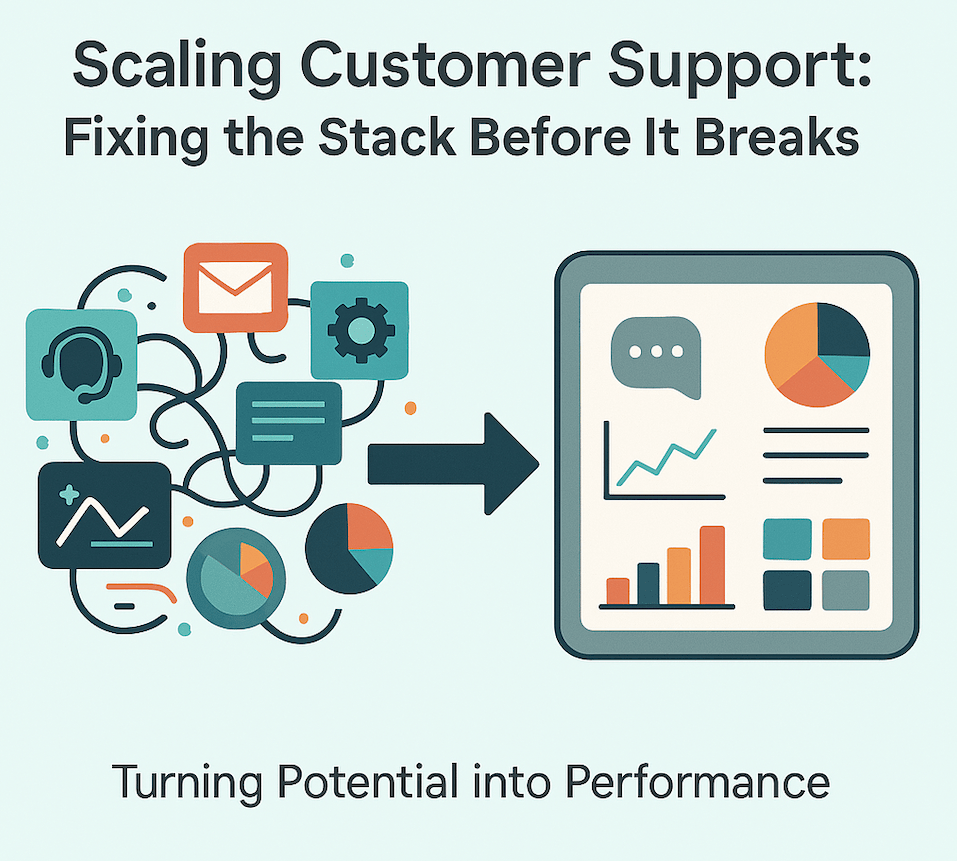
Turning Potential into Performance
Early-stage start-ups are scrappy by design. You grab the first CRM that fits, add a chat tool when tickets pile up, and onboard agents when inboxes start to overflow.
But before you know it, you’ve stitched together a support stack held up by duct tape and goodwill.
And that’s fine, until it isn’t…
As your business scales, so must your customer support strategy. Because what works when you’re handling dozens of queries can quickly collapse under hundreds. And when the tools don’t talk, the tiers blur, and the team’s stretched too thin… It’s not just your support that suffers, it’s your customer experience, retention, and reputation.
What Does a Scalable Customer Support Stack Look Like?
A truly scalable customer support strategy has three core building blocks:
1. Tools That Talk to Each Other
The average support team uses a CRM, a helpdesk, a knowledge base, some form of automation or AI, and at least one internal dashboard. That’s a lot of moving parts.
But if these tools are siloed—if agents are switching tabs and copying data just to resolve a ticket—it slows everything down. Worse, it creates inconsistent service and lost insights.
The solution? A stack built on integration. Choose tools that work together, not just tools that check a box.
2. Tiering Designed for Growth, Not Just Speed
In the early days, it’s tempting to treat every ticket equally. But as volume grows, so should your tiering strategy.
A scalable model routes common, low-risk issues to self-serve channels or AI support, while more complex or high-value cases escalate to trained specialists.
This isn’t about automation replacing humans, it’s about using the right resource at the right time to preserve quality and efficiency.
3. Teams That Evolve With the Business
Many teams start with generalists: one person does everything from onboarding to refunds to tech support.
But that breaks as complexity grows. Scaling customer support means introducing defined roles, clear responsibilities, and professional development—especially for leads, QA, and training functions.
Support should grow as a discipline, not just in headcount.
What Breaks When You Don’t Scale Support Intentionally?
• Duplicate tools and disjointed data
• Overworked agents doing QA on the side
• Slower resolution times
• Customers falling through the cracks
• Leadership flying blind on customer trends
And perhaps most dangerously: support becomes reactive and tactical, not strategic.
What You Can Audit This Month
If your customer support strategy hasn’t had a health check lately, here are four quick wins to look at:
• Are your tools integrated, or are you copy-pasting between platforms?
• Is your tiering clearly defined? Does everyone understand it?
• Are you tracking performance beyond response time?
• Where are the manual workarounds that could be automated or simplified?
Support That Grows With You
Scaling customer support isn’t about throwing more people at the problem. It’s about designing a stack—of tools, tiers, and teams—that can flex, adapt, and perform as you grow.
We work with scaling tech companies to make that happen—bringing clarity to the chaos and turning support from an afterthought into a true business driver.
→ Want help reviewing or rebuilding your support stack?
Whether you’re just getting traction or already scaling, we can help design a support setup that works today and grows with you tomorrow.
